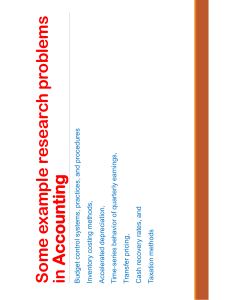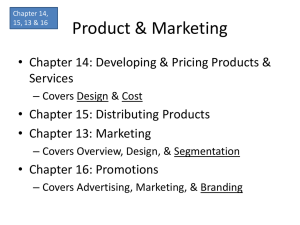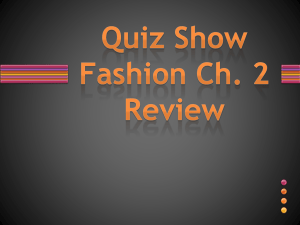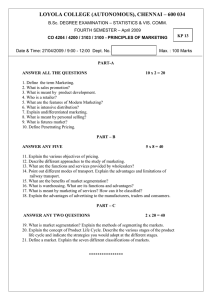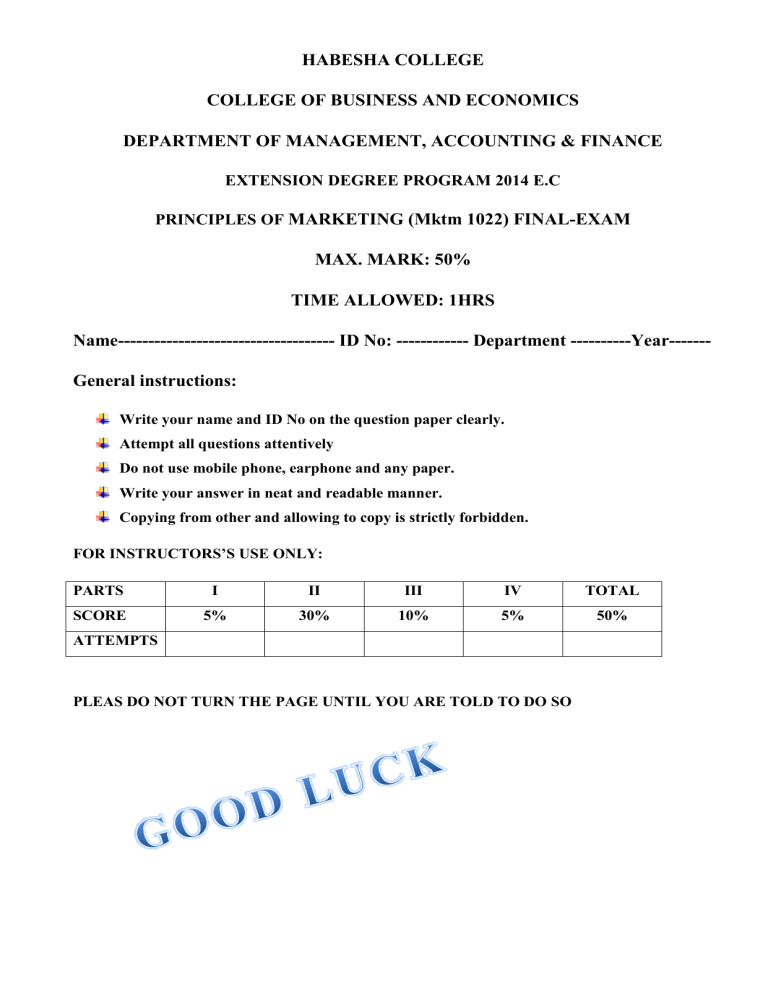
HABESHA COLLEGE COLLEGE OF BUSINESS AND ECONOMICS DEPARTMENT OF MANAGEMENT, ACCOUNTING & FINANCE EXTENSION DEGREE PROGRAM 2014 E.C PRINCIPLES OF MARKETING (Mktm 1022) FINAL-EXAM MAX. MARK: 50% TIME ALLOWED: 1HRS Name------------------------------------ ID No: ------------ Department ----------Year------General instructions: Write your name and ID No on the question paper clearly. Attempt all questions attentively Do not use mobile phone, earphone and any paper. Write your answer in neat and readable manner. Copying from other and allowing to copy is strictly forbidden. FOR INSTRUCTORS’S USE ONLY: PARTS I II III IV TOTAL SCORE 5% 30% 10% 5% 50% ATTEMPTS PLEAS DO NOT TURN THE PAGE UNTIL YOU ARE TOLD TO DO SO Part I: Say: ‘‘True’’ if the statement is correct and ‘‘False’’ if the statement is incorrect (1 pts. each). 1. Sales Promotion is a Short-term incentives used to encourage the purchase of a product or service. 2. Direct marketing is a promotion mix that gain an immediate response and lasting relationship with targeted consumers. 3. Customer value-based pricing uses buyers’ perceptions of value, not the seller’s cost. 4. Price is the sum of all of the values that consumers give up in order to gain the benefits of having or using the product or service. 5. Business analysis involves a review of the sales, costs, and profit projections to assess fit with company objectives. Part II: Choose the best answers from the given alternative (1.5 pts each). 1. A types of market segmentation tailoring products and marketing programs to suit the tastes of specific individuals and locations. A. Micromarketing B. Niche marketing C. Segmented marketing D. mass marketing 2. ----------- is a type of segmentation calls for dividing the market into different geographical units such as nations, regions, states, countries, cities, or even neighborhoods. A. Geographic segmentation B. Demo-graphic segmentation C. Psychographic segmentation D. Behavioral segmentation 3. ----------- a macro environment component and the most dramatic force that shaping the destiny of company. A. Cultural environment B. Social environment C. Technological environment D. Demographic environment E. None 4. Which one of the following are not requirements for Effective Segmentation. A. Measurable B. Substantial C. Accessible D. Inactionable 5. All are main factors that are considered in choosing a Market Coverage Strategy except one, A. Company resources B. Product variability C. Market variability D. PLC E. None 6. A form of product that consists of activities, benefits or satisfactions offered for sale that are essentially intangible and do not result in the ownership of anything. A. Service B. Good C. Core product D. Actual product E. None 7. A type of product which is purchased for further processing or for use in conducting a business . A. Consumer products B. Industrial Products C. A & B D. All 8. --------- are products used over an extended period of time and normally survive for many years. A. Non- durable products B. Service C. Durable products D. None 9. --------------- is the physical good or the delivered service that supplies the desired benefit. A. Core product. B. Supportive service C. Augmented product D. Actual /tangible/product 10. From the following alternatives, which one is not the main characteristic of service? A. Intangibility B. Inseparability C. Perishability D. Variability E. None 11. The market segments should be large or profitable enough to serve. This concept is related to A. Substantial B. Accessible C. Measurable D. Actionable 12. Which of the four major promotional mix element includes building up a positive corporate image and heading off unfavorable stories and events? A. Publicity B. Personal selling C. Advertising D. Sale promotion 13. From the given alternative which one is not the internal factors affecting pricing decisions. A. Marketing mix strategies B. The market and demand C. Overall marketing objectives D. Costs 14. A general pricing approaches adding a standard markup to cost and ignores demand and competition. A. Break-Even Analysis B. Cost-Plus Pricing C. Customer value-based pricing D. Competition-Based Pricing 15. Which one of the following are not elements of the Actual or tangible Product features? A. Quality level B. Features & styling C. Installation and repair D. Brand name 16. A New-Product Development Strategy that a product prototype is made. A. Test marketing B. Commercialization C. Product development D. Business analysis 17. The marketing objectives of introduction stage in product life cycle is-------A. Reduce expenditures and milk the brand C. Maximize market share B. Maximize profits while defending market share. D. Create product awareness and trial 18. A type of market that consists of one seller which may be a government or private firm. A. Oligopolistic competition B. Monopolistic competition. C. Pure competition D. Pure monopoly 19. ------------ is the unplanned static or distortion during the communication process. A. Media B. Message C. Decoding D. Feedback E. Noise 20. From the given alternative, which one are the major Public relations tools. A. News B. Speeches C. Special event D. Written materials Media E. All Part III: Matching the items in column “A” with the items in column “B” (2pts each) COLUMN “A” COLUMN “B” ----- 21. Convenience products A. Frequently purchases and has low price. ----- 22. Shopping produces B. Customers compare carefully on, quality, price, and style. ----- 23. Specialty products C. Strong brand preference and high price. ----- 24. Unsought products D. Requires aggressive advertising and personal selling. ----- 25. Industrial Products E. Products purchased for further processing. F. Products purchased for personal or family consumption. IV. Fill in the blank (1 pts.) 26. ------------------------- is the course of a product’s sales and profits in its lifetime. 27. ------------------------- is the specific blend of advertising, public relations, personal selling, and direct-marketing tools that the company uses to persuasively communicate with consumers. 28. ----------------------------------- is the development of original products, product improvements, product modifications, and new brands through the firm’s own product development efforts. 29. ------------------------------------ Consists of all the product lines and items that a particular seller offers for sale. 30. ------------------------------- are products bought by final consumer for their personal consumption. ANSWER SHEET Name---------------------------------------- ID No: ------------- Department ------------------Year-----------PART I: TRUE/FALSE 1. ------------------------2. ------------------------3. ------------------------4. ------------------------5. -------------------------PART II: MULTIPLE CHOICES 1. ------------------------- 11. ------------------------- 2. ------------------------- 12. ------------------------- 3. ------------------------- 13. ------------------------- 4. ------------------------- 14. ------------------------- 5. ------------------------- 15. ------------------------- 6. ------------------------- 16. ------------------------- 7. ------------------------- 17. ------------------------- 8. ------------------------- 18. ------------------------- 9. ------------------------- 19. ------------------------- 10. ------------------------- 20. ------------------------PART III: MACHING 21. ------------------------ 24. ------------------------- 22. ------------------------- 25. ------------------------- 23. -------------------------

